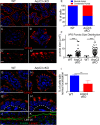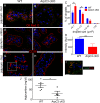The Arp2/3 complex has essential roles in vesicle trafficking and transcytosis in the mammalian small intestine
- PMID: 25833710
- PMCID: PMC4472011
- DOI: 10.1091/mbc.E14-10-1481
The Arp2/3 complex has essential roles in vesicle trafficking and transcytosis in the mammalian small intestine
Abstract
The Arp2/3 complex is the only known nucleator of branched F-actin filaments. Work in cultured cells has established a wide array of functions for this complex in controlling cell migration, shape, and adhesion. However, loss of Arp2/3 complex function in tissues has yielded cell type-specific phenotypes. Here we report essential functions of the Arp2/3 complex in the intestinal epithelium. The Arp2/3 complex was dispensable for intestinal development, generation of cortical F-actin, and cell polarity. However, it played essential roles in vesicle trafficking. We found that in the absence of ArpC3, enterocytes had defects in the organization of the endolysosomal system. These defects were physiologically relevant, as transcytosis of IgG was disrupted, lipid absorption was perturbed, and neonatal mice died within days of birth. These data highlight the important roles of the Arp2/3 complex in vesicle trafficking in enterocytes and suggest that defects in cytoplasmic F-actin assembly by the Arp2/3 complex, rather than cortical pools, underlie many of the phenotypes seen in the mutant small intestine.
© 2015 Zhou et al. This article is distributed by The American Society for Cell Biology under license from the author(s). Two months after publication it is available to the public under an Attribution–Noncommercial–Share Alike 3.0 Unported Creative Commons License (http://creativecommons.org/licenses/by-nc-sa/3.0).
Figures





Similar articles
-
Crucial roles of the Arp2/3 complex during mammalian corticogenesis.Development. 2016 Aug 1;143(15):2741-52. doi: 10.1242/dev.130542. Epub 2016 Jul 6. Development. 2016. PMID: 27385014 Free PMC article.
-
CRISPR-Cas9 Arabidopsis mutants of genes for ARPC1 and ARPC3 subunits of ARP2/3 complex reveal differential roles of complex subunits.Sci Rep. 2022 Oct 28;12(1):18205. doi: 10.1038/s41598-022-22982-8. Sci Rep. 2022. PMID: 36307477 Free PMC article.
-
BRICK1/HSPC300 functions with SCAR and the ARP2/3 complex to regulate epidermal cell shape in Arabidopsis.Development. 2006 Mar;133(6):1091-100. doi: 10.1242/dev.02280. Epub 2006 Feb 15. Development. 2006. PMID: 16481352
-
The ARP2/3 complex: an actin nucleator comes of age.Nat Rev Mol Cell Biol. 2006 Oct;7(10):713-26. doi: 10.1038/nrm2026. Nat Rev Mol Cell Biol. 2006. PMID: 16990851 Review.
-
Cellular and pathophysiological consequences of Arp2/3 complex inhibition: role of inhibitory proteins and pharmacological compounds.Cell Mol Life Sci. 2019 Sep;76(17):3349-3361. doi: 10.1007/s00018-019-03128-y. Epub 2019 May 9. Cell Mol Life Sci. 2019. PMID: 31073744 Free PMC article. Review.
Cited by
-
Attaching-and-Effacing Pathogens Exploit Junction Regulatory Activities of N-WASP and SNX9 to Disrupt the Intestinal Barrier.Cell Mol Gastroenterol Hepatol. 2017 Dec 15;5(3):273-288. doi: 10.1016/j.jcmgh.2017.11.015. eCollection 2018 Mar. Cell Mol Gastroenterol Hepatol. 2017. PMID: 29675452 Free PMC article.
-
Loss of the Arp2/3 complex component ARPC1B causes platelet abnormalities and predisposes to inflammatory disease.Nat Commun. 2017 Apr 3;8:14816. doi: 10.1038/ncomms14816. Nat Commun. 2017. PMID: 28368018 Free PMC article.
-
Membrane Transport across Polarized Epithelia.Cold Spring Harb Perspect Biol. 2017 Sep 1;9(9):a027912. doi: 10.1101/cshperspect.a027912. Cold Spring Harb Perspect Biol. 2017. PMID: 28213463 Free PMC article. Review.
-
Lung Endothelial Transcytosis.Compr Physiol. 2020 Mar 12;10(2):491-508. doi: 10.1002/cphy.c190012. Compr Physiol. 2020. PMID: 32163197 Free PMC article. Review.
-
Microridges are apical epithelial projections formed of F-actin networks that organize the glycan layer.Sci Rep. 2019 Aug 21;9(1):12191. doi: 10.1038/s41598-019-48400-0. Sci Rep. 2019. PMID: 31434932 Free PMC article.
References
-
- Chevrot M, Martin C, Passilly-Degrace P, Besnard P. Role of CD36 in oral and postoral sensing of lipids. Handbk Exp Pharmacol. 2012;2012:295–307. - PubMed
-
- Derivery E, Sousa C, Gautier JJ, Lombard B, Loew D, Gautreau A. The Arp2/3 activator WASH controls the fission of endosomes through a large multiprotein complex. Dev Cell. 2009;17:712–723. - PubMed
Publication types
MeSH terms
Substances
Grants and funding
LinkOut - more resources
Full Text Sources
Other Literature Sources

